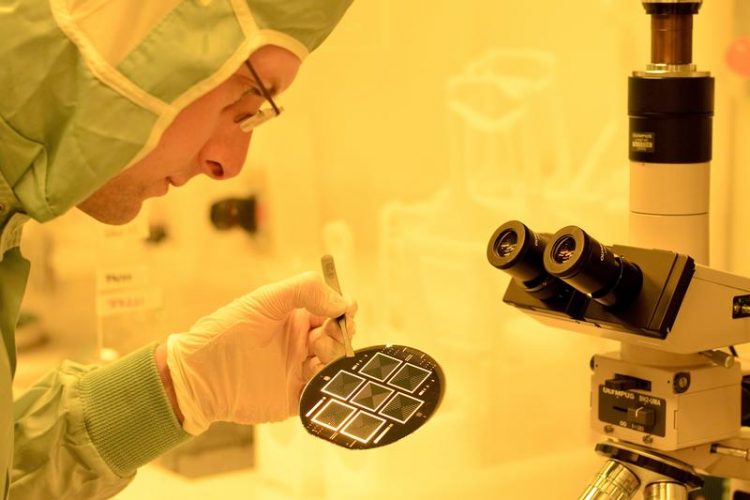Fraunhofer ISE Achieves New World Record for Both Sides-Contacted Silicon Solar Cells

Fraunhofer ISE achieves new world record for both sides-contacted silicon solar cell: TOPCon technology makes 25.1 percent efficiency possible. © Fraunhofer ISE
The Fraunhofer Institute for Solar Energy Systems ISE has set a new efficiency record for silicon solar cells. For the first time, an efficiency of 25.1 percent has been measured for a both sides-contacted silicon solar cell. Having a simple rear side contact without any patterning, this type of solar cell converts one quarter of the incident sunlight into electricity. The new concept for the solar cell rear side holds great potential for further increases in efficiency.
This record achieved by Fraunhofer ISE is the highest efficiency achieved to date for both sides-contacted silicon solar cells, characterized by having metal contacts on both the front and rear sides. This solar cell at 25.1 percent efficiency features a novel concept, namely a full-area passivated back contact.
“To improve the solar cell efficiency, the focus has been on increasingly complex solar cell structures up to now,” explains Dr. Martin Hermle, Head of the High Efficiency Solar Cells department at Fraunhofer ISE. “The biggest advantage of our new concept is that we can now contact the entire rear cell surface without patterning. Compared to the high-efficiency solar cell structures presently in use, we offer both a simplified manufacturing process and higher efficiencies at the same time,” says Hermle.
With the so-called TOPCon (Tunnel Oxide Passivated Contact) technology, developed by Fraunhofer ISE, metal contacts are applied to the rear side without patterning. To achieve this, the Fraunhofer researchers developed a selective passivated contact made of tunnel oxide that enables majority charge carriers to pass and prevents the minority carriers from recombining.
The thickness of the intermediate passivation layer is reduced to one or two nanometers, allowing the charge carriers to “tunnel” through it. Subsequently, a thin coating of highly doped silicon is deposited over the entire layer of ultra-thin tunnel oxide. This novel combination of layers allows electrical current to flow out of the cell with nearly zero loss.
In the photovoltaics industry, the majority of solar cells have an aluminum-alloyed back contact covering the entire rear side. This type of contact, however, limits the efficiency. Therefore, the industry currently retrofits their production to incorporate the PERC (Passivated Emitter Rear Cell) technology in order to increase the solar cell efficiency.
With PERC technology, only a small area on the rear side is contacted in order to reduce recombination. PERC, however, requires additional patterning steps and leads to longer current conduction paths in the silicon wafer. TOPCon, on the other hand, offers a possible approach to reduce these loss mechanisms and increase the efficiency.
“With TOPCon, we have developed a pioneering technology to increase the efficiency of silicon solar cells,” says Prof. Stefan Glunz, Division Director of Solar Cells – Development and Characterization. “At 25.1% efficiency, we are the first research institute to cross the 25 percent mark with an evolutionary further development for both sides-contacted solar cells and to close the gap on the world record efficiency for back contacted solar cells,” adds Glunz.
The team of Dr. Martin Hermle has been working on the TOPCon concept for about three years. The scientists in the team have succeeded in continually increasing the solar cell efficiency using this technology. With their latest result, they have surpassed the 25 percent mark. The research was funded within the project FORTES from the German Federal Ministry for Economic Affairs and Energy and U.S. Department of Energy, Energy Efficiency and Renewable Energy Program, under Award Number DE-EE0006336.
EU PVSEC: Come hear our presentation on this topic!
On Tuesday, September 15, 2015, Prof. Stefan Glunz, Division Director of “Solar Cells – Development and Characterization” will hold a plenary talk on this topic at the European Photovoltaic Conference (EU PVSEC) in Hamburg. The title of the talk is “The Irresistible Charm of a Simple Current Flow Pattern – Approaching 25 % with a Solar Cell Featuring a Full-Area Back Contact” (Plenary Session 2BP.1 from 10:30-12:10 a.m.)
Media Contact
All latest news from the category: Power and Electrical Engineering
This topic covers issues related to energy generation, conversion, transportation and consumption and how the industry is addressing the challenge of energy efficiency in general.
innovations-report provides in-depth and informative reports and articles on subjects ranging from wind energy, fuel cell technology, solar energy, geothermal energy, petroleum, gas, nuclear engineering, alternative energy and energy efficiency to fusion, hydrogen and superconductor technologies.
Newest articles

NASA: Mystery of life’s handedness deepens
The mystery of why life uses molecules with specific orientations has deepened with a NASA-funded discovery that RNA — a key molecule thought to have potentially held the instructions for…

What are the effects of historic lithium mining on water quality?
Study reveals low levels of common contaminants but high levels of other elements in waters associated with an abandoned lithium mine. Lithium ore and mining waste from a historic lithium…

Quantum-inspired design boosts efficiency of heat-to-electricity conversion
Rice engineers take unconventional route to improving thermophotovoltaic systems. Researchers at Rice University have found a new way to improve a key element of thermophotovoltaic (TPV) systems, which convert heat…



